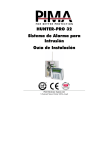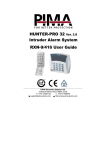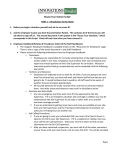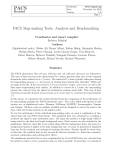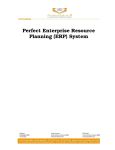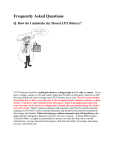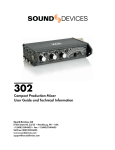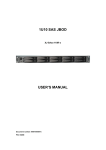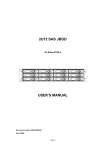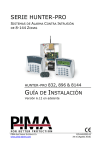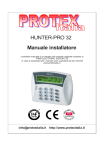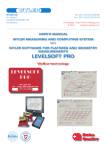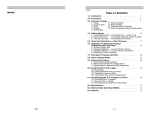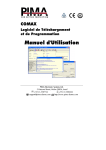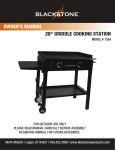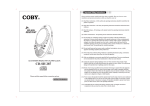Download HUNTER-PRO 32 Intruder Alarm System Installation Guide
Transcript
HUNTER-PRO 32 Intruder Alarm System Installation Guide PIMA Electronic Systems Ltd. 5 Hatzoref Street, Holon 58856, Israel ℡ +972-3-5587722 +972-3-5500442 [email protected] http://www.pima-alarms.com PIMA Electronic Systems Ltd. does not represent that its Product may not be compromised and/or circumvented, or that the Product will prevent any death, personal and/or bodily injury and/or damage to property resulting from burglary, robbery, fire or otherwise, or that the Product will in all cases provide adequate warning or protection. The User understands that a properly installed and maintained equipment may only reduce the risk of events such as burglary, robbery, and fire without warning, but it is not insurance or a guarantee that such will not occur or that there will be no death, personal damage and/or damage to property as a result. PIMA Electronic Systems Ltd. shall have no liability for any death, personal and/or bodily injury and/or damage to property or other loss whether direct, indirect, incidental, consequential or otherwise, based on a claim that the Product failed to function. Warning: The user should follow the installation and operation instructions and among other things test the Product and the whole system at least once a week. For various reasons, including, but not limited to, changes in environment conditions, electric or electronic disruptions and tampering, the Product may not perform as expected. The user is advised to take all necessary precautions for his/her safety and the protection of his/her property. This document may not be duplicated, circulated, altered, modified, translated, reduced to any form or otherwise changed; unless PIMA’s prior written consent is granted. All efforts have been made to ensure that the content of this manual is accurate. Pima retains the right to modify this manual or any part thereof, from time to time, without serving any prior notice of such modification. Please read this manual in its entirety before attempting to program or operate your system. Should you misunderstand any part of this manual, please contact the supplier or installer of this system. Copyright 2004 by PIMA Electronic Systems Ltd. All rights reserved. You can contact us at PIMA Electronic Systems Ltd.5 Hatzoref Street, Holon 58856, Israelhttp://www.pima-alarms.com HUNTER-PRO 32 Intruder Alarm System - Installation Manual 3 TABLE OF CONTENTS Table of Contents ........................................................................ 3 Chapter 1 Introduction ............................................................... 8 1.1 Main Features HUNTER-PRO 32 .............................................9 1.2 Safety Precautions............................................................... 10 1.3 Signs and Abbreviations Key ................................................ 10 1.4 The Control-Panel................................................................ 12 1.4.1 Control Panel Fuses....................................................... 13 1.4.2 The Control Panel’s Connections & Terminals ................. 13 Chapter 2 Partitions.................................................................. 17 2.1 General............................................................................... 17 2.2 Examples ............................................................................ 18 2.2.1 Example A .................................................................... 18 Classical Application for Example A .................................................................18 2.2.2 Example B .................................................................... 19 Classical Application for Example B .................................................................20 2.2.3 Example C .................................................................... 21 Classical Application for Example C.................................................................21 Chapter 3 Installing Peripherals.............................................. 23 3.1 General............................................................................... 23 3.2 Connecting Zones................................................................ 24 3.2.1 Zone Inputs................................................................. 24 3.2.2 Connecting Detector without using EOL resistor......................... 25 3.2.3 Connecting Detector using one EOL resistor ............................. 25 3.2.4 Connecting Detector using two EOL resistors ............................ 27 3.3 Connecting Zone-Expenders (General) ................................... 28 3.3.1 EXP-LOCAL: Local Expansion ......................................... 29 4 HUNTER-PRO 32 Intruder Alarm System - Installation Manual 3.3.3 I/O-8: External Expenders ............................................ 30 3.3.4 RC-PRO: Wireless Expansion.......................................... 31 3.4 Connecting Key/Remote Control ........................................... 32 3.5 TMPR1 and TMPR2 .............................................................. 33 3.6 Connecting Sirens................................................................ 33 3.6.1 Siren without built-in oscillator: Horn (AC)...................... 34 3.6.2 Stand-Alone Siren: Piazzo (DC) ...................................... 34 3.6.3 High-Current Stand-Alone Siren ..................................... 35 3.7 Relay Outputs ..................................................................... 35 3.8 Auxiliary Outputs: ON/OFF (AUX1) ALARM (AUX2).............................. 36 3.9 Expansion Outputs: OUT-1000............................................ 36 3.10 Connecting Keypads ............................................................ 37 3.10.1 LCD Keypads: RXN-400/410 ......................................... 38 3.12 Telephone Line and Devices ................................................... 39 3.13 TRV/TRU-100 ..................................................................... 40 3.13.1 Connecting the Transmitter: .......................................... 40 3.14 Microphone Unit: MIC-100 ................................................... 42 3.15 Connecting Voice Unit: VU-20 .............................................. 42 3.16 Connecting Battery .............................................................. 43 3.17 Connecting Mains ................................................................ 44 3.18 Initializing the System ......................................................... 44 3.18.1 Setting Time:............................................................. 45 Chapter4 Operating & Programming the System.................... 47 4.1 General............................................................................... 47 4.2 Programming Possibilities..................................................... 47 4.2.1 Programming with the Fast Programmer PRG-22 ............ 47 4.2.2 Local Programming with COMAX & LCL-11A....................... 48 3.18.1 Remote Programming with Modem and COMAX........... 49 3.18.2 Programming with a Keypad....................................... 49 4.3 Programming with a Keypad .................................................. 50 4.3.1 PIMA Programming Method ........................................... 50 4.3.1.1 4.3.2.3 4.3.2 4.3.2.1 4.3.2.2 Manu Navigation............................................................................50 Key Menu Description ....................................................................50 Entering “User Menu”.................................................... 51 Using Master Code .........................................................................51 Using User Code ............................................................................51 HUNTER-PRO 32 Intruder Alarm System - Installation Manual 4.3.2.3 5 Using Technician Code ...................................................................52 Chapter 5 Technician Menu ...................................................... 53 5.1 Entering Technician Menu .................................................... 53 5.2 Installing the System ........................................................... 53 5.2.1 Service Provider ............................................................ 53 5.2.2 Wire Expenders............................................................. 54 5.2.2.1 5.2.2.2 Local Expansion .............................................................................54 Remote Expenders.........................................................................54 5.2.3 Wireless Expender ........................................................ 55 5.2.4 Keypads ....................................................................... 56 5.2.5 Keypads Partitions ........................................................ 56 5.3 Zone Programming .............................................................. 57 5.3.1 Zone Characteristics ...................................................... 57 5.3.2 Zone Name................................................................... 59 5.3.3 Partitioning ................................................................... 59 5.3.4 Zone Responses (Templates)......................................... 59 5.3.4.1 Zone sensitivity..............................................................................60 5.4 Communication Parameters ................................................. 60 5.4.1 Communication to Central Monitoring Station ........................ 61 5.4.1.1 5.4.1.2 5.4.1.3 5.4.1.4 5.4.1.5 5.4.1.6 5.4.1.7 5.4.2 5.4.2.1 5.4.2.2 5.4.2.3 5.4.2.4 5.4.3 5.4.4 5.4.4.1 5.4.4.2 5.4.4.3 Number of Central Monitoring Stations ...........................................61 Telephone Numbers.......................................................................61 Monitoring Station 1 Options ..........................................................61 Monitoring Station 2 Options ..........................................................62 Partition Account Numbers .............................................................62 General Monitoring Station Options ................................................63 Report Codes 4x2 ..........................................................................63 Radio Transmitter ......................................................... 65 Radio Protocol ...............................................................................65 Number of transmissions................................................................65 Periodicity Test ..............................................................................65 Radio Report Codes .......................................................................65 Modem Call Back .......................................................... 66 Communication Features ............................................... 66 Number of Rings............................................................................66 External Line .................................................................................67 Programming Telephone Line .........................................................67 5.5 TIMERS .............................................................................. 68 5.5.1 Entry/Exit Delay ............................................................ 68 6 HUNTER-PRO 32 Intruder Alarm System - Installation Manual 5.5.2 Programming Outputs Time........................................... 69 5.5.3 AC Report Delay ........................................................... 70 5.5.4 Soak Test Days ............................................................. 70 5.5.5 Double Knock ............................................................... 70 5.5.6 Conditioned Zones Time ................................................ 71 5.5.7 Bypass Limit Time ......................................................... 71 5.5.8 False Code.................................................................... 71 5.6 General Parameters ............................................................. 72 5.6.1 General Parameters First Screen .................................... 72 5.6.2 General Parameters Second Screen................................ 73 5.7 System Responses............................................................... 74 5.7.1 System in ON State ....................................................... 75 5.7.2 System in OFF State...................................................... 75 5.8 Programming Outputs.......................................................... 76 5.8.1 Polarity......................................................................... 76 5.8.2 Output Cards ................................................................ 76 5.9 Programming the Entire System ........................................... 76 5.9.1 Initializing System ......................................................... 77 5.9.2 Local Download ............................................................ 77 5.9.3 Fast Programming......................................................... 77 5.10 Installer Code...................................................................... 78 5.11 Tests .................................................................................. 78 5.11.1 Walk Test .................................................................. 78 5.11.2 Wireless Test............................................................. 79 5.11.3 Wireless TAMPER Test ............................................... 79 5.11.4 Configuring Soak Test Zones ...................................... 80 5.11.5 Siren Test.................................................................. 80 5.11.5 Monitoring Station Dialer Test .................................... 80 5.11.6 Central Monitoring Station Radio Test ......................... 80 5.12 Remote-Controlling via Telephone ........................................ 81 Chapter 6 Name Programming ................................................. 83 Chapter 7 Troubleshooting ....................................................... 84 7.1 Restoring Master & Technician Codes ................................... 84 7.2 Displaying System Faults ..................................................... 85 7.3 Solutions............................................................................. 86 HUNTER-PRO 32 Intruder Alarm System - Installation Manual 7.3.1 7.3.2 7.3.3 7.3.4 7.3.5 7.3.6 7.3.7 7.3.8 7.3.9 7.3.9.1 7.3.9.2 7.3.9.3 7.3.9.4 7.3.9.5 7 Clock............................................................................ 86 Battery ......................................................................... 86 Low DC ........................................................................ 86 AC Line......................................................................... 87 Tamper ........................................................................ 87 Zone ............................................................................ 87 Keyboard Not Connected ............................................... 87 Telephone .................................................................... 88 Communication............................................................. 88 No telephone communication to MS during test mode .....................88 Checking communications to the Monitoring Station:.......................89 No Wireless Communication to CMS ...............................................89 No Communication to Private Dialer................................................89 System not answering Telephone Calls ...........................................89 7.3.9 Automatic Arming Failure .............................................. 90 7.3.10 Open Zone does not cause Alarm ............................... 90 Chapter 8 Tables ....................................................................... 91 10.1 Programming System Defaults ............................................. 91 10.2 Central-Station Report Formats ............................................ 98 10.2.1 Pulse Formats ............................................................... 98 10.2.2 DTMF Formats ......................................................... 101 8 HUNTER-PRO 32 Intruder Alarm System - Installation Manual CHAPTER 1 INTRODUCTION HUNTER-PRO 32 Intruder Alarm System contains numerous features that allow it to befit the customer’s individual needs, and yet remain easy to program and use both by the customer and the technician. The HUNTER-PRO 32 is secured against radio-frequency (RF) interference and electro-magnetic disturbances (EMI). In this guide you will find installation instructions, description of programming possibilities and further information that shall help you install and operate the system. IMPORTANT! For every-day operation uses, please see HUNTER-PRO 32 User Guide booklet, which is an integral part of the Installer Guide. Furthermore, the User Guide includes user’s programming parameters instructions, which is crucial for operating the system. For any further questions, please do not hesitate to contact your local PIMA distributor or PIMA directly at: PIMA Electronic Systems Ltd. Tel.: +972–3–558 7722 Fax: +972–3–550 0442 Email: [email protected] Up to date literature is available to download from our website: www.pima-alarms.com HUNTER-PRO 32 Intruder Alarm System - Installation Manual 9 1.1 Main Features HUNTER-PRO 32 8 to 32 zones with wireless add-on, local, and remote bus expanders Supports a wide range of partition options: Up to 16 partitions each with it own Account ID and Users Up to 8 subsystems each with different keypads, IDs, etc. Full supervision data of wireless detectors (supervision, low battery, tamper) Comprehensive Zone Tests for flawless installation: Walk Test, Soak Test, etc. Two options for viewing system status: Detailed: Scrolling events, zones’ and system’s status “PIMA” Style: Status of all 32 zones is displayed simultaneously Four Subscriber dialing numbers with optional voice message Four Monitoring Stations phone numbers PIMA unique Integrated Digital Communicator (telephone, long-range radio) Supports split and double reporting to two monitoring stations with different account IDs LCD keypad with multilingual Menu-Driven screens for easy programming and operation Many alternatives for easy programming (Keypad, Fast Programmer, Local/Remote download software) Up to 24 users with various authorization levels Various accessories (mic, voice unit etc.) Memory Log up to 410 events Automatic Arming at a preset time and/or after a preset silence time System remote control via any touchtone telephone HUNTER-PRO 32 Intruder Alarm System - Installation Manual 10 1.2 Safety Precautions Your HUNTER-PRO 32 alarm system has been registered with the CE in accordance with EN 60950 of its rules. The CE requires us to tell you the following information: To reduce the risk of fire or electric shock, do not expose this alarm system to rain or moisture. Do not open the door of the alarm system. Dangerous high voltages are present inside of the enclosure. Refer servicing to qualified personnel only. This alarm system should be used with AC 230V, 50Hz. To prevent electric shocks and fire hazards, do NOT use any other power source. Do not spill liquid of any kind onto the unit. If liquid is accidentally spilled onto the unit, immediately consult a qualified service. Install this product in a protected location where no one can trip over any line or power cored. Protect cords from damage or abrasion. Disconnect all sources of power supply before proceeding with the installation. Connect the AC wires to the terminal block on the PCB as marking. Pay attention to polarity. 1.3 Signs and Abbreviations Key Key press Press and hold key, until confirmation beep is heard Save data Press this key at any programming stage in order to return to root screen Default Master Code: 5555 “Enabled User Code”: A code enabled by technician to enter the user menu HUNTER-PRO 32 Intruder Alarm System - Installation Manual 11 “LCD Zone Numbers”: Referring to the frame of zones engraved above and below the LCD display window, indicating the zones’ numbers. CMS: Central Monitoring Station CAV052 A5 F Z1 F5 A 1 Z2 Z4 + Z5 Z6 Z7 JP2 KEYPAD Z8 + C HUNTER-PRO - C F4 - N.O N.C RELAY SMOKE 16 S1 S2 SIREN F3 JP5 1 U2 - T1 + IN OUT ALARM ON/ TMPR TMPR KEYPAD OFF 1 2 JP4 SERIAL 15 KEY F2 20 - F1 U3 EXPANSION CARD 13 Z3 F6 JP6 1 F7 JP1 TRANSMIT 14 CAV052 A51. 3 F 2 DUA NI T UO TNOC T ES 18 E NI L 12 HUNTER-PRO 32 Intruder Alarm System - Installation Manual 1.4 The Control-Panel 12 11 9 10 9 9 8 7 6 17 5 19 4 3 3 HUNTER-PRO 32 Intruder Alarm System - Installation Manual 1.4.1 13 Control Panel Fuses Regular Fuses (2) F5 (5 Amp) - protects the battery from a short on the PCB. F6 (5 Amp) - protects the AC from a short on the PCB. Thermal Fuses for limiting current (5) F1 – Detector power supply (750mA) F2, F3 – Siren1 and Siren2 (1.1A) F4 – Keypad power supply (750mA) F7 – Protection for long-range radio transmitter 1.4.2 The Control Panel’s Connections & Terminals ① AC – Voltage Input 14VAC input supplied by the transformer. 2 Connections to Backup Battery Two wires connect the backup battery to the PCB. The red wire connects to the positive (+) contact of the battery and the black wire connects to the negative (–) contact of the battery. IMPORTANT! Ensure correct connection of battery polarity! Switching the polarity can damage the PCB. 3 Z1–Z8 – Zone Inputs Zone inputs can be connected to all types of detectors with dry contact outputs. All zones can be connected with single or double EOL resistors NOTE: The number of zones can be doubled by connecting line/wireless expenders (refer to section 3.2 for expending options in HUNTER-PRO 32. 14 HUNTER-PRO 32 Intruder Alarm System - Installation Manual 4 (+) – Power Supply for Detectors Power supply for detectors that require DC operating voltage, such as infrared detectors, beam-detectors etc. 5 KEY – Key or remote Arming Input Use momentary or ON/OFF key to arm/disarm the system. 6 S1, S2 – Siren 1 and Siren 2 Outputs Two siren outputs connected to the same on-board sound generator (driver). Connect the second siren connection is to a ground (-) connection. Each siren has a dedicated automatic thermal fuse F2 and F3 (see section 3.6) 7 RELAY – Internal Relay Connections Three connections to a relay mounted on the PCB. Can be used to activate various auxiliary accessories such as external lighting, CCTV, external communicator, electric locks, etc . The three outputs are C (common), NO (normally open) and NC (normally closed). 8 SMOKE – Switched Ground Switched GND for smoke detectors that require reset. Any zone can be programmed to be a “smoke detector” input; its activation will cause the GND to disconnect for approximately one minute. Manual reset is done by pressing and holding the key. 9 KEYPAD – Connection to keypads There are four Keypad terminals: Voltage power supply (–) and (+) .OUT is for data from the control panel to the keypad, and IN is for data from the keypad to the control panel. An automatic thermal fuse F4 protects the 13.8 VDC power supply. Up to 8 RXN 400/410 keypads can be connected simultaneously. ALRM and ON/OFF – Auxiliary Outputs These terminals have two conditions: disconnect or short to ground. These outputs serve as indicators to auxiliary units as to system status and alarm status (see section 5.8). HUNTER-PRO 32 Intruder Alarm System - Installation Manual 15 ⑪ TMPR1 and TMPR2 – Tamper Inputs Inputs for tamper switches from detectors and boxes that can be connected with/without EOL resistor/s. Different responses can be programmed to arm/disarm system status. These inputs can serve as indicators other than tamper, for example: thermostat, 24 hours zone monitoring, panic button etc (see section 3.5). ⑫ LINE – Connection to Telephone Line A telephone line connection for dialing private numbers and to Monitoring Stations, and for remote programming. For best results connect as close as possible to the line source to provide best protection against tampering. ⑬ SET – Connection to telephone set Connection to a telephone set or answering machine. Do not connect a fax machine or modem if you enable “line snapping” or “2 rings snapping”. ⑭ AUD IN, AUD OUT, CONT – Connections to Mic. and Voice modules CONT activates voice and microphone modules VU-20 and MIC-100. Connect AUD IN to the audio outputs from the microphone and voice modules. AUD OUT is yet to be determined (refer to section 3.14 and 3.15). NOTE: The VU-20 and MIC-100 cannot be connected simultaneously. ⑮ JP4 SERIAL- Serial Input JP4 connects to a wireless detector receiver RC-PRO and home control system. For further information, refer to section 3.3.4. ⑯JP3 – Connection to Expansion Cards Connection to Output Expansion Cards OUT-1000 and EXP-PRO (refer to section. 3.2 and 3.9). ⑰ JP2 KEYPAD – Connection to Technician Keypad Connection to Technician Keypad (using the Technician Cable TC-3). 16 HUNTER-PRO 32 Intruder Alarm System - Installation Manual ⑱ TRANSMIT – Connection to Long-Range Radio Transmitter Connection to PIMA long-range radio transmitters TRU/TRV-100. NOTE: It is possible to connect long-range transmitters other than PIMA’s by connecting the TX-1000 adaptor. ⑲ JP5-Select Siren Type Connection to two types of sirens: with internal oscillator/driver (speakers) and without internal oscillator/driver (horn). In the first case, short pins 1 and 2, in the second case, short pins 2 and 3. NOTE: DC is useful only when connecting the Siren. ⑳ JP6-Select Siren Power Source Connection to siren power source (for external power source, short pins 1 and 2; for using the Battery as the power source, short pins 2 and 3.) HUNTER-PRO 32 Intruder Alarm System - Installation Manual 17 CHAPTER 2 PARTITIONS 2.1 General HUNTER-PRO 32 can consist up to 16 partitions that are controlled by different user codes, different keypads, or, on the other hand, share the same keypads. This chapter scans the different partitioning options in HUNTER-PRO 32. 1. The system can be divided into 16 partitions that are controlled individually by a different user code, or share the same user code (refer to HUNTER-PRO 32 User Manual for programming this feature). Up to 8 keypads can be installed and it/they will display the whole 16 partitions as a single system (see example A in the next page). 2. The system can be divided up to 8 sub-systems with 8 different keypads (max), when each sub-system is controlled by a different keypad or shares the same keypad (see example B and C in the following pages). 18 HUNTER-PRO 32 Intruder Alarm System - Installation Manual 2.2 Examples 2.2.1 Example A Keypad 1 Partition 1 Partition 2 User 1 Partition 3 User 2 User 3 Drawing 1-Using partitions (example A) In example A: Keypad 1 controllers 3 partitions User 1 can only activate partition 1 User 2 can only activate partition 2 User 3 can only activate partition 3 NOTE: The system can be divided up to 16 partitions (max) with 8 keypads (max), when all the keypads are identical in terms of controlling all the partitions and displaying their status. Classical Application for Example A 0.63m 0.63m Partition 8 Partition 7 Partition 6 Partition 5 Partition 4 Partition 3 Partition 11 Partition 12 Partition 13 Partition 14 Partition 15 Entran ce Partition 10 Partition 1 Keypad Hallway Partition 9 Partition 2 Partition 16 In an office building, there is a floor with 16 offices. A keypad is installed at the entrance of the offices’ hallway, and each of the offices has a different user HUNTER-PRO 32 Intruder Alarm System - Installation Manual 19 code for arming/disarming the system. In this case, the keypad will display the entire system’s status. A detector that is allocated to several partitions can be installed in order to protect the entrance of the offices’ hallway (i.e. a zone shared by several/all partitions). Allocating the entrance zone to all partitions will protect the entrance, providing all partitions are armed. This zone will be inactive with the first user that disarms his partition. 2.2.2 Example B Keypad 1 Keypad 2 Partition 1 Partition 2 User 1 User 2 Keypad 3 Partition 3 User 3 Keypad 8 Partition 8 User 8 Drawing 2-Using partitions (example B) In example B: Each partition has it own individual user code and keypad (e.g. user 1 can activate partition1 but not partition 2). A user can only arm/disarm his partition only by using his allocated keypad (e.g user 1 can only arm/disarm his partition using keypad 1). Each keypad presents only its allocated partition’s status (meaning, keypad 1 displays only partition 1 status, keypad 2 displays only partition 2 status, and so on). NOTE: The keypad displays only its allocated partition’s status, including arming/disarming the partition, opened zones allocated to this partition, and zones that triggered the alarm. 20 HUNTER-PRO 32 Intruder Alarm System - Installation Manual Classical Application for Example B Storage floorpartition 4 Keypad 4 Management floorpartition 3 Keypad 3 Production floor partition 2 Keypad 2 Store (floor) partition 1 Keypad 1 A company building is divided into 4 departments that have different entrances and different working hours: Each of the departments has its own individual keypad. Accordingly: Keypad 1 is allocated to partition 1 (store floor) Keypad 2 is allocated to partition 2 (production floor) Keypad 3 is allocated to partition 3 (management floor) Keypad 4 is allocated to partition 4 (storage floor) In addition, partition 1 can be controlled by a single user code or several user codes (vital for foreman and storage workers, for example). NOTE: You can also limit disarming hours and other authorizations for each user. HUNTER-PRO 32 Intruder Alarm System - Installation Manual 2.2.3 21 Example C Keypad 1 Keypad 2 Partition 1 Partition 2 User 1 User 2 Keypad 3 Keypad 8 Partition 3 Partition 8 User 3 User 8 Drawing 3- Using sub-systems (example C) Classical Application for Example C Roof Partition 3 Keypad 3 Second floor Partition 2 Keypad 2 First floor Partition 1 Keypad 1 In a private home there are 3 floors: the first floor is partition 1, the second floor is partition 2, and the third floor is partition 3. User and keypad allocation: Keypad 1 controls partition 1,2,3 (displays all partitions’ status) Keypad 2 only controls partition 2 (displays only partition 2 status) Keypad 3 only controls partition 3 (displays only partition 3 status) User 1 can activate partitions 1,2,3 using keypad 1 User 2 can activate partition 2 from keypad 1,2 User 3 can activate partition 3 from keypad 1,3 NOTE: It is possible for a user to control several partitions using a single code. 22 HUNTER-PRO 32 Intruder Alarm System - Installation Manual HUNTER-PRO 32 Intruder Alarm System - Installation Manual 23 CHAPTER 3 INSTALLING PERIPHERALS 3.1 General Connect the various accessories according to the following diagram and instructions: HUNTER-PRO 32 Intruder Alarm System - Installation Manual PSTN + IN OUT ALARM ON/ TMPR TMPR KEYPAD OFF 1 2 Keypad BUS RX404, RX414, or RX200 RET NUH ORP (-) Smoke detector (+) Z8 F1 + KEY F2 U3 Z7 10K ¼W NO - 10K ¼W Z4 Z3 Z1 F5 Z2 JP6 F6 JP1 F7 + Z5 Z6 JP2 KEYPAD TRANSMIT 10K ¼W - S1 S2 SIREN F3 JP5 1 C EXPANSION CARD F4 - U2 N.O N.C RELAY SMOKE - JP4 T1 DU A NI T U O TNOC SERIAL 10K ¼W Tel set TES MIC or Voice Unit E NI L 24 F 5A 052CAV F 5A 052CAV A C 12VDC 7.2AH MAX NC AC 3.2 Connecting Zones IMPORTANT! Always disconnect battery and mains power supply when you connect and disconnect wires. 3.2.1 Zone Inputs You can connect each zone input with 0/1/2 EOL resistors. Define each zone in the “system configuration” accordingly. The number of resistors you connect HUNTER-PRO 32 Intruder Alarm System - Installation Manual 25 (one or two) is defined as a general rule for all the zones (refer to section. 5.3.1). 3.2.2 Connecting Detector without using EOL resistor Connect a detector with NC output (for example, Defender-2K) without EOL resistor according to the below diagrams. There are several options to connect the tamper outputs from the detectors: serial connection that can be connected to the tamper input in the control panel, or to a zone that is defined to as 88 “24 hours”. The Tamper can also be connected in serial to the relay output of the detector. NOTE: When connecting NO detector, make sure the zone input is configured NO as well (refer to section. 5.3.1). TAMPER NC + - JP1 PIR1 RELAY NC JP2 3.2.3 Tamper Zone Common Zone Common Connecting Detector using one EOL resistor Connect an NC detector (for example, DEFENDER) with one EOL resistor according to the below diagrams. The tamper can be connected to the control panel’s tamper output, or a “24 hour” zone. NOTE: When connecting NO detector, make sure the zone input is configured NO as well (refer to section. 5.3.1). For tamper configuration: section 5.6). Connecting EOL resistor to NC PIR Detector TAMPER NC + - + TAMPER NC RELAY NC One EOL resistor connected to a NC detector JP2 PIR1 (-) - RELAY NC JP1 JP1 Zone Common Zone 10K ¼W TAMPER 10K ¼W 10K ¼W Tamper Zone Common 10K ¼W Zone PIR (NC) Common HUNTER-PRO 32 Intruder Alarm System - Installation Manual 26 One EOL resistor in serial to the relay and the TAMPER JP2 PIR1 Separate connections for the relay and the TAMPER; each with a dedicated EOL resistor TAMPER 10K ¼W TAMPER NC + - RELAY NC (-) PIR1 TAMPER NC Common 10K ¼W + - RELAY NC JP1 JP1 Zone Zone 10K ¼W 10K ¼W Common Common Zone PIR (NO) Tamper Zone Connecting EOL resistor to NO PIR Detector JP2 PIR1 JP2 HUNTER-PRO 32 Intruder Alarm System - Installation Manual One EOL resistor connected to a NC detector 3.2.4 One EOL resistor in serial to the relay and the TAMPER 27 Separate connections for the relay and the TAMPER; each with a dedicated EOL resistor Connecting Detector using two EOL resistors Connect a detector with NC output (for example, Defender-2K) with two EOL resistors according to the below diagrams. If you use the NO output from the detector then the zone should be configured as such (for zone configuration, refer to sections 5.3.1; For tamper configurations, refer to section 5.6.) Two EOL resistors with a Normally Closed (NC) PIR PIR (NC) 13K ¼W Common (-) JP2 RELAY NC TAMPER - 10K ¼W Zone Zone + JP1 PIR1 13K ¼W TAMPER NC 10K ¼W 2 EOL resistors with a NC output 2 EOL resistors connected to a TAMPER in serial connection to a NC output Two EOL resistors with a Normally Open (NO) PIR 28 HUNTER-PRO 32 Intruder Alarm System - Installation Manual PIR (NO) TAMPER NC 13K ¼W RELAY NO TAMPER Common - (-) JP2 Zone 13K ¼W + JP1 PIR1 10K ¼W Zone 10K ¼W 2 EOL resistor with a NO output 2 EOL resistors connected to a TAMPER in serial connection to a NO output 3.3 Connecting Zone-Expenders (General) It is possible to expand HUNTER-PRO 32’s zones and outputs by using different expansion cards and Add-On devices. The following is a brief scan of the zone and outputs expansion options. A detailed installation description is found later on (check the section reference at the end of each expansion option.) Zone numeration in HUNTER-PRO 32 is dynamic. However, there is a set priority as to the zones’ chronological order. See table 1. IMPORTANT! Remember HUNTER-PRO 32 supports up to 32 zones, even if the expansion cards have more than 32 zones. Expansion Option Zone number allocated by system Control Panel 1-8 EXP-LOCAL 9-16 I/O-8-External Expender 1 17-24 I/O-8-External Expender 2 25-32 1-8 1-8 1-8 1-8 1-8 ( 2) ( 2) ( 2) ( 2) 17-24 9-16 9-16 9-16 ( 2) 25-32 17-24 17-24 ( 2) ( 2) HUNTER-PRO 32 Intruder Alarm System - Installation Manual 29 I/O-8-External Expender 3 ( 1) ( 1) 25-32 ( 2) ( 2) ( 2) RC-PRO-Wireless Expansion ( 1) ( 1) ( 1) 25-32 17-32 9-24 ( 3) Table 1-Zone Numeration in HUNTER-PRO 32 (1) Cannot be installed in the system since quantity of zones exceeds 32 (2) Not installed in the system (3) It is possible to use only 8 out of the receiver’s 16 wireless zones 3.3.1 EXP-LOCAL: Local Expansion An 8-zone expansion card, used for connecting 8 additional wired zones. These zones are identical to those of the HUNTER-PRO 32, and shall always be programmed in the system as zones 9 to 16. NOTE: Disconnect all of the system’s power sources before installing the expansion card. To connect the EXP-LOCAL: 1. Use the two supplied screws to connect the card to the control panel’s box 2. Use the supplied Flat Cable to connect between the card and JP3 (see Drawing 4). 3. To configure the Expansion Card refer to “Expansion Outputs” section 3.9. +V +V EXP-LOCAL GND GND Z 9 Z 16 U3A Z 15 Z 10 Z 14 Z 11 Z 12 TRANSMIT JP1 Z 13 J1 EXPANSION CARD KEYBOARD JP2 SERIAL JP3 JP4 U3 R C F5 U2 Drawing 4 Connecting EXP-LOCAL to control panel 30 HUNTER-PRO 32 Intruder Alarm System - Installation Manual 3.3.3 I/O-8: External Expenders A zone and output expansion card connected to the keypad’s communication lines (BUS). The card has 8 zones and one relay output. It is possible to install up to three I/O-8 cards (providing an EXP-LOCAL is not installed) in order to expend the system to 32 zones. Each card has an individual ID number configured by the jumpers on it (see Drawing 2 and the card itself to determine ID number). Card ID No. 1 2 3 JP4 Jumper position JP3 JP2 JP1 Table 2- Determining I/O-8 ID number IMPORTANT! Two cards cannot have the same ID number. The cards need be configured in a chronological order and without missing a number The card’s ID number determines the number of zones connected to it (see table 1). NOTE: It is recommended to connect the +V to the expansion card, separately from the control panel. To connect the I/O-8: Follow the table below in order to connect the card/s to the control panel’s bus HUNTER-PRO 32 Intruder Alarm System - Installation Manual 31 HUNTER-PRO 32 - + + IN OUT KEYPAD -V +V 3 4 zones I RXN-400/410 1-V 2+V SUB 3 I/O-8 EXP-1 4 REPMAT KEYBOARD ID=1 REPMAT I 1-V 2+V SUB 3 I/O-8 EXP-2 4 REPMAT KEYBOARD ID=2 REPMAT I 1-V 2+V SUB 3 4 KEYBOARD DrawingID=3 5-Connecting external expansion cards on control panel’s bus In order to configure the number of I/O-8 cards connected to the system, see expender menus in section 5.2.2.2. 3.3.4 RC-PRO: Wireless Expansion An integral wireless receiver that supports up to 16 zones and 18 remote controls (for arming/disarming/panic). Used for connecting wireless detectors (such as PIR, Reed Switch etc.), sensors, panic buttons and remote controls. 32 HUNTER-PRO 32 Intruder Alarm System - Installation Manual Along with the RC-PRO the HUNTER-PRO 32 becomes a Hybrid system that supports both wired and wireless detectors. To connect the RC-PRO: Use the Communication Cable to connect the control panel to the serial output. Follow Drawing 6 and Table 3). RC-PRO T AM PER DIP 3 4 5 6 7 8 IN OUT GND 12V In Audio H UNTER-PRO 32 Out Control SE RAL Drawing 6-Connecting RC-PRO to control panel Wire color RC-PRO Red 12V Black GND Green OUT White IN Table 3-Connecting RC-PRO 3.4 Connecting Key/Remote Control Connect the key or remote control receiver according to the diagram below with a 10kW EOL resistor on the PCB terminal input. The key can be momentary or ON/OFF switches. The default is connection to momentary key. NOTE: Make sure momentary key is programmed when connecting remote control. F3 KEY Z5 Z6 Z7 Z8 - F2 + Control Panel Key (NC) (-) - Key 33 S1 S2 SIREN HUNTER-PRO 32 Intruder Alarm System - Installation Manual Drawing 7-Connecting spring key to control panel 3.5 TMPR1 and TMPR2 These inputs are used to monitor the control panel box, detector housings and siren cases using tamper switches. This input can also be utilized for panic buttons, temperature sensors with dry contact outputs and more. Connect the tamper switch to the input, TMPR1 or TMPR2 and the ground (–). A 10 kW EOL resistor at the terminal input on the PCB. The EOL provides a short/disconnect indication since the tamper switches are of the NO type. NOTE: Default programming is that both TAMPER inputs are enabled and without EOL. Refer to the “System Configuration” screen in order to change the defaults (section 5.6). JP5 Control Panel F3 F2 Z5 Z6 Z7 Z8 - + KEY - - S1 S2 SIREN SMOKE - + IN OUT ALARM ON/ TMPR TMPR KEYPAD OFF 1 2 TAMPER switch Drawing 8-Connecting tamper to control-panel 3.6 Connecting Sirens Three siren types can be connected to HUNTER-PRO 32 34 HUNTER-PRO 32 Intruder Alarm System - Installation Manual IMPORTANT! Different siren types cannot be connected simultaneously. 3.6.1 Siren without built-in oscillator: Horn (AC) A Siren without a built-in oscillator (AC). Consumes up to 200 mA. The siren is connected between terminal block outputs (S1, S2) and GND (-). The siren’s sounds are produced by HUNTER-PRO 32 inner built-in oscillator. When the zones’ features are configured (see section 5.3.1), it is possible to program different siren sound to different zones. Make sure that in “General Parameters” screen (section 5.6) the siren is not configured as DC (mark a “-“ under the “D” letter parameter). + IN OUT KEYBOARD SIREN 2 C S1 S2 SIREN - SIREN 1 GND Z8 - + KEY F2 JP5 F3 N.O N.C RELAY SMOKE - F4 Also make sure that JP5 shorts legs 2 and 3 (see drawing 6). Drawing 9 Connecting AC Siren 3.6.2 Stand-Alone Siren: Piazzo (DC) A Siren with a built-in oscillator (DC). Consumes up to 200 mA. The siren is connected between terminal block outputs (S1, S2) and Auxiliary Power (+). HUNTER-PRO 32 Intruder Alarm System - Installation Manual 35 Make sure that in “General Parameters” screen (section 5.6.1) the siren is configured as DC (mark a “+“ under the “D” letter parameter). - N.O N.C RELAY SMOKE - + IN KEYBOAR Also make sure that JP5 shorts legs 1 and 2 (see drawing 7). CONTROL KEY Z8 - + F2 - S1 S2 SIREN F3 JP5 1 2 3 C Siren with oscilliator Drawing 10 Connecting DC Siren 3.6.3 High-Current Stand-Alone Siren DC Siren with a high-current oscillator (consumes 3 Amp). The siren is connected between terminal block outputs (S1, S2) and Auxiliary Power (+). Make sure that JP5 shorts legs 2 and 3. Make sure that JP6 shorts legs 1 and 2. In “General Parameters” screen (section 5.6) the siren is configured as DC (mark a “+“ under the “D” letter parameter). 3.7 Relay Outputs The relay can be used for activating external devices (light, CCTV etc.) and there are several ways to activate it (zone is activated, pressing Relay Code on keypad, via telephone, and as response to faults/events). Connect the relay outputs NO/NC/COM to activate the designated device. To program Relay Code refer to “HUNTER-PRO 32 User Manual”. To program relay activation time see section 5.5.2 “Output Time” 36 HUNTER-PRO 32 Intruder Alarm System - Installation Manual NOTE: If Relay Time is programmed as zero, the relay is constantly activated until Relay Code is entered or the system is switched OFF. 3.8 Auxiliary Outputs: ON/OFF (AUX1) ALARM (AUX2) HUNTER-PRO 32 has two outputs for general use. In “General Parameter” screen (see section 5.6) the default is that AUX1 is designated for arming/disarming the system and AUX2 for the keypad’s buzzer. AUX1 switches (-) when activating system (ON/OFF output) system default AUX2 switches (-) at time of alarm (ALARM output) system default Also, these outputs can be allocated for further uses when the zone’s responses are configured (see section 5.3.4). IMPORTANT! Configuring ON/OFF and/or ALARM in one of the zone responses cancels the configuration in General Parameters screen. 3.9 Expansion Outputs: OUT-1000 It is possible to add up to 8 outputs activated by an alarm for peripheral devices such as CCTV, alarm triggered lights, etc. IMPORTANT! Disconnect any of the system’s power sources before installing the card Follow the drawing 8 in order to connect the card to the control panel: 37 GND OUT8 7 6 5 4 3 2 1 12V HUNTER-PRO 32 Intruder Alarm System - Installation Manual GND J1 J2 TRANSMIT EXPANSION CARD KEYBOARD JP1 JP2 SERIAL JP3 JP4 U3 R AC F5 U2 Drawing 11-Connecting OUT-1000 to control panel Use the cable to connect the control panel’s JP3 connector to OUT-1000’s JP1 connector. NOTE: OUT-1000 can be connected simultaneously with EXP-LOCAL by connecting OUT-1000’s JP2 to EXP-LOCAL’s JP1 (see OUT-1000 Manual for instructions). Configure the outputs’ polarity Configure which partition activates which output in “Output Configuration” screen (see section 5.8). 3.10 Connecting Keypads Connect the keypad’s “+” “-“ “IN” “OUT” outputs to the compatible ones on control panel. NOTE: Up to 8 keypads can be connected to the system. IMPORATNT! The 4 wires used to connect the keypad must be totally separate. The keypad’s power source (-) / (+) cannot be used for detectors. 38 HUNTER-PRO 32 Intruder Alarm System - Installation Manual 3.10.1 LCD Keypads: RXN-400/410 + IN OUT ALARM ON/ TMPR TMPR KEYPAD OFF 1 2 1 JAN 04 12:40 3 - F4 Control Panel RXN-410 S1 S2 SIREN - F3 JP5 C - N.O N.C RELAY SMOKE 2 Drawing 12-Connecting LCD keypad to control panel PIMA’s new keypads contain a tamper switch that “supervises” the keypads connected to the system. In order to enable this feature: 1. Configure exactly the number of keypads connected to the system: Short JP1 legs 1 and 2 on the keypad (see drawing 11). RJ11- connecting to the fast programmer (PRG-22) and local programming adaptor LCL-11A TAMPER U1 TAMPER TAMPER TAMPER JP1: Programming number of keypads BUS 4 IN 3 OUT 2+V PROGRAMMING JP1 1 1-V + Terminal block connection to control panel Drawing 13-LCD keypad without back cover Then, in the following programming screen, enter desired number of keypads (1 to 8): Enter new To finish, short JP1 legs 2 and 3 (i.e. return the jumper). 2. Each of the keypads need be given a unique ID number. ID: 1 HUNTER-PRO 32 Intruder Alarm System - Installation Manual 39 Important! If keypad supervision is not needed, The number of keypads connected to the system is not to be configured The keypads’ ID need be set as zero (0). Note Up to 8 keypads can be connected to the system, whether they have supervision or not. 3.12 Telephone Line and Devices It is preferable that the PSTN line connects directly to the LINE input so that the system will be the first device connected to the line. This type of connection will prevent disconnecting the system and enable efficient “line snapping”. AUD IN OUT SET LINE Control Panel T1 CONT The rest of the telephone devices (telephone, answering machine, etc.) need be connected to the SET terminal block in order to enable “line snapping” (i.e. at time of an alarm these devices will be disconnected and the system will be able to dial even if the line is busy by one of them). TELEPHONE OUTLET F4 OUT ALARM ON/ TMPRTMPR OFF 1 2 Drawing 14- Connecting telephone line to control panel IMPORTANT! A fax machine or a modem can only be connected to SET input if “line snapping” is enabled. 40 HUNTER-PRO 32 Intruder Alarm System - Installation Manual NOTE: “2 Ring Snapping” from telephone devices is not connected to “2 Ring Snapping” parameter in “General Parameters” screen. 3.13 TRV/TRU-100 The TRV–100/ TRU-100 is a long-range radio transmitter for communicating with a Monitoring Station. IMPORTANT! Note the below mounting guidelines for installing a Control Panel with an integrated transmitter. Following these guidelines will minimize RF interference: Do not mount the Panel close to a metal wall or ceiling Make sure you leave enough space for the antenna between the metal box and the ceiling Install the antenna at a distance from the Control Panel’s wiring Mount the antenna after you complete all other installations Make sure the antenna is straight Close the HUNTER-PRO metal box when performing transmission tests 3.13.1 Connecting the Transmitter: NOTE: The TRV/TRU-100 can transmit in two frequencies. 1. Mount the HUNTER-PRO 32 metal box on the wall 2. Screw the transmitter to the box (4 screws at the base of the antenna.) Make sure the screws are tightened; else, the transmitter’s range can be reduced. 3. Connect the antenna to the transmitter. Make sure the antenna is straight. 4. Make sure the 5-pin cable is connected to the transmitter’s Molex (named: “To the system” on the transmitter’s sticker.) 5. Connect the other end of the 5-pin cable to the male Molex, placed on the Control Panel’s upper left side (named “Transmitter” on the Control Panel.) Using the second frequency only: HUNTER-PRO 32 Intruder Alarm System - Installation Manual 41 Follow the pervious 1 to 5 instructions, and then: Connect the 2-pin cable to the transmitter’s F2 Molex (named F2 on the transmitter’s sticker.) Connect the other end of the 2-pin cable to the control panel depends on the desired transmitter operation: To constantly work with the second frequency: Connect it to a negative (-) output on the Control Panel. To work with the two frequencies according to event’s type: Connect it to one of the system’s outputs, such as AUX1/AUX2 Program these outputs in “Zone Responses” screen (see section 5.3.4) The suitable parameters need be programmed in “Communication Configuration” screen (see section 5.4). 4 screws (at the base of the antenna) Molex for connecting 5-pin cable Molex for connecting 2-pin cable Connection to program connector Drawing 15-Cable connections to TRV/TRU-100 42 HUNTER-PRO 32 Intruder Alarm System - Installation Manual Program TRV/TRU-100 F To the 2 System Antenna connector DPR-44 comax TRANSMITTER Control Panel PC Drawing 16- Connecting TRV/TRU-100 to control panel 3.14 Microphone Unit: MIC-100 Connect Mic-100’s IN output to the control panel’s OUT terminal. Connect Mic-100’s OUT output to the control panel’s AUD IN terminal. Connect MIC-100’s (-) and (+) to the detectors’ power source. NOTE: MIC-100 is supplied without wires. AUD OUT IN CONT T1 IN OUT MIC Unit JP5 Control Panel LINE SET + GND(-) F2 F3 F4 Z6 Z7 Z8 - + KEY - S1 S2 SIREN OUT ALARM ON/ TMPRTMPR OFF 1 2 Drawing 17- Connecting MIC-100 to control panel 3.15 Connecting Voice Unit: VU-20 Connect VU-20’s TR input to the control panel’s CONTROL output Connect VU-20’s AUDIO output to the control panel’s AUD IN input HUNTER-PRO 32 Intruder Alarm System - Installation Manual 43 Connect MIC-100’s (-) and (+) to the detectors’ power source. yellow TR(+) blue AUDIO V(+) SET AUD IN OUT CONT T1 Voice Unit VU-20 F2 F3 Z5 Z6 Z7 Z8 - + KEY - S1 S2 SIREN F4 red black Control Panel LINE GND(-) JP5 OUT ALARM ON/ TMPR TMPR OFF 1 2 Drawing 18-connecting VU-20 to control panel 3.16 Connecting Battery The HUNTER-PRO 32 incorporates a rechargeable 12V backup battery. The charging voltage for the battery is 13.8 V. The system performs two battery tests as well as a manual test: “Low level” test”: A continuous monitoring for battery failures such as a disconnected wire, poor contact, etc. “Under load” test”: Checks the battery capacity. This test is conducted in the following cases: Each time the system is armed. Every day at 24:00. Upon applying power to the system. NOTE: If the "under load" test fails, the system will respond as programmed in the failure responses (sounding sirens, dialing the Monitoring Station, etc.). Manual battery test: Enter the Master Code then press and hold the key for a complete system check that also includes a battery check. 44 HUNTER-PRO 32 Intruder Alarm System - Installation Manual 3.17 Connecting Mains IMPORTANT! Verify that the power cord is disconnected from the mains power supply. Connect the three power cord wires to the connection terminals of the Power Supply terminals. Verify that the transformer outputs are connected to the AC terminals on the PCB, and that the transformer supplies 2A. With an Ohm meter, check for continuity between the grounding point on the control panel, PCB and GND terminal, to the electrical outlet grounding point. The resistance must be less than 1 Ohm. Now you can connect the power cord to the mains power source (230VAC). NOTE: A current limit device, such as a circuit breaker, fuse, etc., must be connected in series to the power cord. You must connect the Electrical grounding! Connect AC mains power supply. Connect the backup battery to the fast connection terminals, red wire to (+) and black wire to (-). IMPORTANT! Failing to connect the cables as described will permanently damage the control panel! NOTE: If you connect the battery before the Mains (AC), an AC FAULT will be displayed until you connect the AC. The AC FAULT will be logged in memory. 3.18 Initializing the System Make sure the connections to the system are in order as described in previous sections. HUNTER-PRO 32 Intruder Alarm System - Installation Manual 45 Connect AC mains power supply. Connect the backup battery to the fast connection terminals, red wire to (+) and black wire to (-). IMPORTANT! Failing to connect the cables as described will permanently damage the control panel! NOTE: If you connect the battery before the Mains (AC), an AC FAULT will be displayed until you connect the AC. The AC FAULT will be logged in memory. Close the control panel case and verify that the screws do not touch the battery. When connecting the voltage (AC or battery) a buzz is extracted from the keypad, and the display shows the keypad’s type, version, and ID. After a few Drawing 6-HUNTER-PRO 32 seconds the regular display returns (see drawing 6). System Display Then, the Fault LED blinks, and a message that the clock is not set. After all faults are handled, the red LED ceases to blink and the Default Display disappears. 1 JAN Clock 04 00:00 not set 3.18.1 9 Setting Time: USER/MASTER CODE USER MENU Choose 1,2... Enter time (HH:MM format) and Enter Full Date and then press 9 and then 8 46 HUNTER-PRO 32 Intruder Alarm System - Installation Manual NOTE: Use the right. and Another way to access User Menu: 9 Technician Code keys to move the cursor to the left and to the HUNTER-PRO 32 Intruder Alarm System - Installation Manual 47 CHAPTER4 OPERATING & PROGRAMMING THE SYSTEM 4.1 General The HUNTER-PRO 32 is supplied with factory default parameters. In most installations you will have none or a few parameters to program, except for user-specific parameters such as telephone numbers, zone names etc. 4.2 Programming Possibilities There are four different ways to program the HUNTER-PRO 32: Fast Local-Uploading with the PIMA Fast Programmer PRG–22. The PRG-22 connects to any LCD keypads Local Up/Download with a PC, LCL–11A PC interface, and COMAX software Remote Up/Download over the telephone line with a PC, modem, and dedicated COMAX software from PIMA Manual programming with LCD keypad 4.2.1 Programming with the Fast Programmer PRG-22 This type of programming can be done only via the installer menu and an LCD Keypad. Connect the PRG-22 to the designated connector according to the following drawing. In RXN-400/410 LCD keypad models the RJ-22 connector is internal, on the PCB’s upper left side. Refer to section. 5.9.3 for fast programming procedures. HUNTER-PRO 32 Intruder Alarm System - Installation Manual 1 JAN 04 12:53 OP: TOMAS OFFICE O UT OUT + IN K EYBO AR D F4 ALARM O N/ OF F TMPR 1 TMPR 2 48 IN +V F3 S1 SIREN KEY - JP5 S2 C N .O REL AY N .C - SM OKE - -V PRG-22 Drawing 19-Connecting LCD Keypad to Control Panel and PRG-22 4.2.2 Local Programming with COMAX & LCL-11A In order to commence local programming with the COMAX software, you need to use the LCL-11A adaptor. The LCL-11A is an interface between the HUNTERPRO 32 system and a PC with the COMAX Upload/Download Software. The LCL-11A provides fast, easy, and convenient programming. You can program the parameters in advance and “upload” them after you complete the installation. The LCL-11A connects to the PCB inside the customer’s keypad (on the PCB’s upper left side). Refer to section. 5.9.3 for fast programming procedures. HUNTER-PRO 32 Intruder Alarm System - Installation Manual F4 O UT + IN K EYBOAR D ALARM ON/ OF F TMP R TMP R 1 2 1 JAN 04 12:53 OP: TOMAS OFFICE OUT IN +V -V F3 S1 SI REN KEY - JP5 S2 C - N. O N. C R ELA Y S M O KE - 49 LLC A 11 COMAX D-type 9 pin PC to PC Serial (RS-232) Port e.g., COM1 Drawing 20-Connecting Keypad to Control Panel and COMAX 3.18.1 Remote Programming with Modem and COMAX You can program the HUNTER-PRO 32 over a telephone line with a PC, PIMA modem, and the COMAX programming software. In addition to programming, you also have access to the memory log. Please refer to the COMAX User Manual for detailed information 3.18.2 Programming with a Keypad In addition to the above programming methods, it is always possible to program HUNTER-PRO 32 directly through the keypad. For your comfort, all the system’s functions are organized in friendly and easy to use manuals HUNTER-PRO 32 has two types of menus: User Menu: One-press keys in order to facilitate use and speed programming procedure. The function is written above the keypad’s keys and you only need to enter the Master Code/User Code, and then press the desired key 50 HUNTER-PRO 32 Intruder Alarm System - Installation Manual Technician Menu: The technician’s programming screens are organized in menus 4.3 Programming with a Keypad 4.3.1 PIMA Programming Method S RK121 23HTB L + ---_+ +++-- - Drawing 21- Example for a Zone Status Bar All programmable parameters in HUNTER-PRO 32 are divided according to subjects presented in menus. Additionally, the Zone Status Bar greatly facilitates field programming in cases of “YES/NO” options by presenting all these options in a single screen. _ reaches one of the parameter letters, the display When the blinking sign changes for 3 seconds and shows the this function’s full name and a brief description. 4.3.1.1 Manu Navigation Navigation is possible through the menus and parameters by using the following keys: EXIT/DELETE key. Pressing this key deletes changes enacted on parameters or exits a current menu. BACKWARDS/FORWARDS keys navigating between a Menu’s options or parameters presented in the same screen, and between the options in the YES/NO programming screens (i.e. Zone Status Bar, section 4.3.1). SELECTION/CONFORMATION key. Pressing this key selects the desired menu or option presented on screen. After changing parameters, pressing this key confirms and saves the changes in the system’s Memory. RESET key. Pressing this key resets parameters in screens where numbers are programmed (i.e. telephone numbers, Account Numbers to Monitoring Station, etc.) 4.3.2.3 Key Menu Description HUNTER-PRO 32 Intruder Alarm System - Installation Manual Installing a system .....................................................page 53 Zones........................................................................page 57 Communication ..........................................................page 60 Timers.......................................................................page 68 General Parameters....................................................page 72 System Responses......................................................page 74 Output Programming ..................................................page 76 Programming the entire system...................................page 76 Technician Code.........................................................page 78 Test ..........................................................................page 78 4.3.2 Entering “User Menu” There are three ways to enter the user menu: 4.3.2.1 9 Using Master Code MASTER CODE 4.3.2.2 9 0 User Menu Choose 1,2.. Using User Code USER CODE Menu 9 User Choose 1,2.. 51 52 HUNTER-PRO 32 Intruder Alarm System - Installation Manual NOTE: When the parameter (M) is enabled (User Code>Menu) in General Parameter screen (see section 5.6), it is possible to enter the user menu directly without long-pressing the key. In this case, actions such as arming and disarming are not automatically activated and the arming/disarming key must be pressed. For example, for arming the system you enter the user code, and then press the key. User Code is not authorized to change Master Code. 4.3.2.3 9 0 Using Technician Code TECHNICIAN CODE Menu 9 User Choose 1,2.. NOTE: When the User Menu is accessed with Technician Code, it is impossible to change codes. HUNTER-PRO 32 Intruder Alarm System - Installation Manual 53 CHAPTER 5 TECHNICIAN MENU 5.1 Entering Technician Menu System Default Codes 5555 Master Code 1234 Technician Code In order to enter Technician Menu: 9 MASTER CODE User Menu Choose 1,2.. NEXT 9 TECHNICIAN CODE Technician Menu Choose 1,2.. -OR- 9 TECHNICIAN CODE Technician Menu Choose 1,2.. 5.2 Installing the System 9 1 Sys Installation ENTER/NEXT/END ENTR In this screen the system’s general parameters are programmed (parameters such as names, type of expender, amount of keypads etc.) In this menu the following functions are programmed as well: 5.2.1 Service Provider 9 ENTER/NEXT/END 1 Sys Installation ENTR Service Provider ENTER/NEXT/END ENTR 54 HUNTER-PRO 32 Intruder Alarm System - Installation Manual In this screen it is possible to program the system supporter’s name and phone number. key in order to view the entered information (this Press and hold the feature is possible only when the system is in OFF mode). In order to see how to enter names (letters and digits), turn to Chapter 8: “Name Programming”. 5.2.2 9 Wire Expenders 1 Sys Installation ENTER/NEXT/END ENTR NEXT Expanders ENTER/NEXT/END ENTR In this screen you program the type of Wire Expenders installed in the system. 5.2.2.1 Local Expansion XM _- NEXT BACK ENTR The mark “+” under the “X” signifies that an 8-additional-zones local expender is installed in the system (EXP-LOCAL). NOTE: It is not possible to simultaneously install in the system local expender and zone doubling. The mark “+” under the “M” signifies that zones 1 to 8 are regular zones while zones 9 to 16 are doubled zones (using a resistor and a diode). To change the mark from “-“ to “+” and vice versa use key To move backwards/forwards between “x” and “M use and To enter “X” and “M” parameters use 5.2.2.2 Remote Expenders key keys HUNTER-PRO 32 Intruder Alarm System - Installation Manual Remote Expanders 0 55 ENTR In this screen you program the amount of remote expenders (I/O-8) installed on the keypad’s BUS. It is possible to install up to three expenders in the system. NOTES: If a parameter larger than possible is entered into the system, the system will reset the parameter. If the EXP-LOCAL expender is installed, only two more expenders can be added to the system. 5.2.3 Wireless Expender Sys Installation 9 1 ENTR Wireless Expand. 0 Zones ENTER/NEXT/END ENTR NEXT x2 Wireless Expand. ENTER/NEXT/END In this screen you program the amount of wireless zones connected, if a wireless expender is installed in the system. It is possible to program up to 16 zones. IMPORTANT! The wireless zones are programmed only after the other expenders. Meaning: If there are no other expenders, the wireless zones are 9 to 24. If there is a local expender, the wireless zones are 17 to 32. If all the ‘wire expenders’ possible are installed, it is not possible to install wireless zones (for the zone numeration table, refer to section 3.3). After programming the number of wireless zones in the system, you need to program the Jam Signal Level and the duration of time for the Supervision signals (i.e. “life signals”). Block Level: 0 Supervision: 0 56 HUNTER-PRO 32 Intruder Alarm System - Installation Manual Jam Signal Level: The receiver’s frequency minimum signal level (RSSI) to which the system will respond. There are 11 levels from which you can choose, rating from “0” to “10”. “0” means this feature is neutralized and from “1” until “10” there is s gradual rise. NOTE: Jam Signal Level has to appear for at least one minute before the system can respond to it. Supervision Signal: The duration of time (in hours) in which the Control Panel expects to get a Supervision signal from each of the wireless detectors. IMPORTANT! Since wireless PIR detectors transmit a Supervision signal approximately every three hours, the duration of time between each signal has to be longer than 3 hours. 5.2.4 Keypads 9 1 ENTER/NEXT/END ENTR Keypads Setup 0 Keypads Sys Installation ENTR NEXT X3 Keypads Setup ENTER/NEXT/END In this screen the total number of keypads connected to the system is programmed (remember there cannot be more than 8 keypads). For example, entering this data is required when a TAMPER switch is used to protect the keypads. 5.2.5 Keypads Partitions If a number of keypads were configured in the system, it is possible to allocate them to partitions: 17 18 19 20 21 22 23 24 25 26 27 28 29 30 31 32 Part. for RKD 2 -++--------++--1 2 3 4 5 6 7 8 9 10 11 12 13 14 15 16 HUNTER-PRO 32 Intruder Alarm System - Installation Manual 57 For example: if keypad 2 is designated to work with partition 2, a “+” is to be marked above 2 in the LCD screen. NOTE: Keypad partitions are only activated in case of a partitioned system. 5.3 Zone Programming 9 2 Zones ENTER/NEXT/END ENTR In this menu all the system’s zones are programmed (wired, wireless, original and expanded). In this menu the following functions are programmed: 5.3.1 9 ENTR Zone Characteristics 2 Zones ENTER/NEXT/END Alarm ZONE 1 After the bar is programmed press 1 ENTR ENTR ENTR Zone Configur. ENTER/NEXT/END BOFHHIDTEPDE ---++_-++--- and move to the next zone In this screen the zone’s characteristics are programmed (i.e. Alarm, Panic, Smoke). The characteristics can be changed according to “Zone Responses” (refer to section 5.3.4). It is also possible to program the zones with different Alarm, Panic or Smoke characteristics. In addition to the three basic characteristics there is: Special Alarm 1, Special Alarm 2, Special Alarm 3, Special Panic and Special Smoke Only after setting the zones’ shared characteristics the changes concerning specific zones can be programmed. Each of the following characteristics can be programmed for each of the zones: 58 HUNTER-PRO 32 Intruder Alarm System - Installation Manual NOTE: Par. To navigate on bar, use and keys. Marking a “+” under a parameter’s letter enables the zone with this parameter. Marking a “-” denies this possibility. In order to change the mark from “-“ to “+” (and vise versa) use Para. Full Name Enabling this parameter means… B Bypassed Permanently (+) Permanently bypass a zone 0 Normally Open (+) Connect NO detector to a zone F 24 Hour Zone (+) Zone active 24 hours H Active in Home 1 (+) Zone active in Home 1 H Active in Home 2 (+) Zone active in Home 2 I Entry Delayed (+) When system is armed this zone does not activate alarm immediately (only after Entry Delay time) Possible to program two different sets of Entry Delay time. D Zone Follower (+) When system is Armed and this zone is activated after Entry Delayed zone, it does not activate alarm immediately (only after Entry Delay time). . T Second Delay Time (+) In order to choose the second “Delay Time” E EOL Resistors (+) Zone protected by EOL resistor/s. For determining if system uses one EOL or two, refer to “General Parameters” in section 5.6. HUNTER-PRO 32 Intruder Alarm System - Installation Manual 59 P Following Zone (+) Zone activates alarm only when his “paired” zone activated alarm. D Double Pulse (+) Zone activates alarm only after two successive pulses occur in the duration of time set in Timers Menu. E Customer Cancel (+) Cancel zone before arming the system (user cannot cancel Smoke Zone or Panic Button). 5.3.2 2 Zone Name Zones ENTER/NEXT/END Zone Number: ENTR Zone Name ENTER/NEXT/END NEXT ENTR 1 In this screen the zones’ names are programmed (refer to chapter 8 for further instructions how to program names). 5.3.3 2 Partitioning Zones ENTER/NEXT/END Part. For Zone1 +---_----------- Drawing 22-Allocating zones to a partition 5.3.4 2 ENTR NEXT x2 Partitioning ENTER/NEXT/END ENTR In this screen you set the partitions to which the zones are allocated. Setting the partitions along with setting the keypads’ partitions determines the nature of the system (i.e. Split System / Partitioned System). Further explanation on Partition and Split options is found in chapter 2). Zone Responses (Templates) Zones ENTER/NEXT/END ENTR NEXT X3 Zones Responses ENTER/NEXT/END ENTR 60 HUNTER-PRO 32 Intruder Alarm System - Installation Manual SRKOA123HTBL +---_++++--- Drawing 23-Zone Responses screen In this screen the three basic zone responses are programmed: Alarm Panic and Smoke. All the zones that get the same characteristics shall have the same responses (refer to Zone Programming” in section 5.3.1). In addition to these three, there is also: Special Alarm 1, Special Alarm 2, Special Alarm 3, Special Panic and Special Smoke. S: Siren 3: Expender 3 Output R: Relay H: Private Dialer K: Smoke Output T: Different Siren Tone O: ON/OFF B: Automatic Bypass A: ALARM L: 1: Expender 1 Output 2: Expender 2 Output No Monitoring Station during daytime (e.g. Fire Exit) Zone sensitivity 5.3.4.1 After programming the zone characteristics in each if the three basic groups (Alarm, Panic and Smoke), you need to program the zones’ sensitivity by multiplying the characteristics by 50msec (for example, to program 200msec sensitivity, press 4). In order to access this screen, press after zone configuration is finished: Sensitiv.(X50mS) 5.4 Communication Parameters In this menu all the system’s communication functions are programmed: the Monitoring Stations, Telephone Numbers, Report options, Formats, etc. HUNTER-PRO 32 Intruder Alarm System - Installation Manual Communication to Central Monitoring Station 5.4.1 9 61 3 Communication ENTER/NEXT/END ENTR Commun. to MS ENTER/NEXT/END ENTR In this menu all the functions related to the Monitoring Station are programmed. 5.4.1.1 Number of Central Monitoring Stations of MS 9 Number ENTER/NEXT/END To change between double/single report press ENTR Number Double of MS Report NEXT Number Single of MS MS In this screen it is possible to choose between a single or double report to the Monitoring Station. In case of a double report, the two first telephone numbers belong to Monitoring Station 1, and the third and forth telephone numbers belong to Monitoring Station 2. 5.4.1.2 9 Telephone Numbers Commun. to MS ENTER/NEXT/END Phone Numbers ENTER/NEXT/END Phone 2<Delete=# Phone 4<Delete=# ENTR ENTR ENTR Number of MS ENTER/NEXT/END Phone 1<Delete=# Phone 3<Delete=# NEXT ENTR ENTR ENTR In this screen you program the telephone numbers of those Monitoring Stations to which events are reported. Each Monitoring Station is programmed to receive reports to certain events (i.e. Alarm, Panic, Smoke etc.). 5.4.1.3 Monitoring Station 1 Options In this screen all features of Monitoring Station 1 are programmed. 62 HUNTER-PRO 32 Intruder Alarm System - Installation Manual Monitoring Station Protocol: In this screen the Monitoring Stations’ are programmed. MS 0 1 Protocol 230 Monitoring Station Reports: APFOLTWI _+++++++ 1 In this screen the type of events reported to the Monitoring Station are programmed: A: Alarms T: Tests P: Panic W: Wake-up test F: Fire I: Pressing technician code O: Open/Close L: Faults 5.4.1.4 Monitoring Station 2 Options In this screen all features of Monitoring Station 2 are programmed. All screens and programming procedures are similar to those in Monitoring Station 1. 5.4.1.5 Partition Account Numbers Account Pho:0 No.1 Rad:0 In this screen the Partitions’ Account Numbers (1-16) for telephone (Pho.) and RF Transmitter (Radio) reports are programmed. IMPORTANT! In case Splits and Partitions are programmed in the system, their Account Numbers need be programmed as well. If an Account Number is not programmed, there will be no report for its Partition/Split. In a system with no Partitions/Splits, all settings will be registered under “Partition 1”. HUNTER-PRO 32 Intruder Alarm System - Installation Manual 5.4.1.6 63 General Monitoring Station Options In these screens the Communication’s different features are programmed: Test Time and Interval: Test Time:00:00 Interval:24 Hrs Test Time: The automatic test time is programmed in 24 hour format (HH:MM). Note that the test time is similar to that of the PSTN communication and radio backup to monitoring station. Interval : The time between communications with the Monitoring Station is programmed. The test is done by wired line (telephone) and wireless line (Radio or GSM, depending on which is installed.) Wait Time: In this screen you program the waiting time (in seconds) until getting a confirmation sound from the Monitoring Station. Ack Wait time 20 Seconds 5.4.1.7 Report Codes 4x2 These screens enable to program the different events’ Report Codes in 4x2 format (including all American formats.) Each of the code’s digits can receive the value “0” to “15”. Values “10” to “15” are represented by the letters “A” to “F” respectively, thus: A=10 C=12 E=14 B=11 D=13 F=15 Changing a Report Code: Enter the event you want to change Place the cursor on the event’s digit using Press the keypad keys in order to choose a digit from “0” to “9” and keys HUNTER-PRO 32 Intruder Alarm System - Installation Manual 64 Press the key as many times as needed in order to choose a letter between “A” and “F” Event Table in 4 x 2 Format Z1 ,Z2 ... ,Z32 R1 ,R2 ... ,R32 ZFL BYP R1 ,R2 ... ,R32 TM1- ו,TM2 AC LB PF PHN FUS TST PNC ARM DISAR FCODE Alarms according to zones. RESET Code according to zones- reported after Siren Time. When the system is programmed for reset according to zone, the code will be reported only if the zone was closed. Faults according to EOL zones Bypass Zones RESET Code according to zones- reported after Siren Time. When the system is programmed for reset according to zone, the code will be reported only if the zone was closed. Open TAMPER 1 and/or TAMPER 2 and their Reset Codes Mains voltage failure (AC Fall) and Reset Code. Low Battery and Reset Code Card voltage lower than 9 volts (System Shutdown) and Reset Code. Low card voltage indicates AC Fall and Low Battery. Telephone Line Fail and Reset Code. Detector Voltage Fault and Reset Code. Test (manual, automatic, or “wake-up”). Panic Arming System Disarming System False Code Note In the display, the Reset Code appears as “REST” to the event’s right. In case of a Double Report it is impossible to send a different 4X2 report to both Monitoring Stations. It is possible to send a 4X2 report to one Monitoring Station, and send a PAF or Contact ID report to the other Monitoring Station. HUNTER-PRO 32 Intruder Alarm System - Installation Manual 65 Different Double Report Options MS Format 1 MS Format 2 Event Report to MS 1 Event Report to MS 2 PIMA American American Contact ID American PIMA Contact ID PIMA PIMA American Contact ID Contact ID Contact ID PIMA Default Programming* Programming Default Programming Default Default Default Default Programming Default Default Default Default *Programming: 5.4.2 According to the installer’s programming. Radio Transmitter In this screen the radio transmitter protocols are configured. 5.4.2.1 Radio Protocol Protocol: 0 No. of Trans:5 In this screen the Radio Protocol Code is programmed. The code can be retrieved from PIMA’s Technical Support department. 5.4.2.2 Number of transmissions The number of transmissions for each event sent to the monitoring station. The number can range from 1 to 32. 5.4.2.3 Periodicity Test In this screen you program the time between radio communication tests to the monitoring station (hours and minutes). Periodicity Test Hrs:24 Min.s:0 5.4.2.4 Radio Report Codes HUNTER-PRO 32 Intruder Alarm System - Installation Manual 66 Raddio Rep. Codes ENTER/NEXT/ENF ENTR Z1 :FF Z3: FF Z2:FF Z4:FF Press ENTR to move to the next report codes In these screens the Report Codes to the different Radio Formatted events is programmed. Each of the code’s digits can receive the value “0” to “15”. Values “10” to “15” are represented by the letters “A” to “F” respectively, thus: A=10 C=12 E=14 B=11 D=13 F=15 Changing a Report Code: Enter the screen of the event you want to change by pressing Place the cursor on the event’s digit by using and To enter digits/letters representing digits: Use keypad keys in order to choose a digit from “0” to “9” Press the key as many times as needed in order to choose a letter between “A” and “F” 5.4.3 9 3 Modem Call Back Communication ENTER/NEXT/END ENTR NEXT Modem Call back ENTER/NEXT/END ENTR In this screen you program up to 3 telephone numbers that re-call the modem. It is another safety measure that allows only the installer with COMAX software to enter the alarm system (in order to reconfigure parameters). 5.4.4 Communication Features 9 Communication ENTER/NEXT/END 3 ENTR NEXT X2 Commun. Options ENTER/NEXT/END In these screens you program the system’s communication features (telephone line, automatic test, wake-up test). 5.4.4.1 Number of Rings ENTR HUNTER-PRO 32 Intruder Alarm System - Installation Manual 67 No. of Rings ENTER/NEXT/END In this screen you program the number of rings before the system picks up an incoming call. 5.4.4.2 External Line External Line _ In this screen the area code is programmed in case the system needs an external line in order to make the call (due to switch-board system or a code to access the external line). Entering the number in this screen saves time of re-entering the numbers in all those screens where telephone numbers for communication are programmed. 5.4.4.3 Programming Telephone Line PTLLTAVDR _---+---- To enable feature: “+” under parameter To disable feature: “-“ under parameter NOTE: To navigate on bar, use In order to change the mark from “-“ to “+” (and vise versa) use and keys. Par. Para. Full Name Enabling this parameter means… P Connected PSTN System connected to PSTN line T No dial-tone Dials immediately without checking first for a dial tone 68 HUNTER-PRO 32 Intruder Alarm System - Installation Manual check (in case system connected via switch-board/ non standard PSTN) L Checking line in ON PSTN checked every minute the system is on L Checking line in OFF PSTN checked every minute the system is off T Tone Dialing “+” For DTMF Answering Machine In case of two rings, hang-up, waiting for 10 seconds and then another ring, system features line snapping. A “-“ For PULSE NOTE: Make sure answering machine picks calls after more than two rings V Voice Unit A voice-unit is connected to the system D Block RemoteCharge Connecting to COMAX via modem is disabled. Possible to bypass this feature by pressing Master Code and then ENTER twice. R Block Remote Disarm Remotely disarming the system is disabled. 5.5 TIMERS In this menu all the timers in the system are programmed. 5.5.1 4 Entry/Exit Delay Timers, Counters ENTER/NEXT/END ENTR Entry/Exit Delay ENTER/NEXT/END ENTR In this screen Entry delay 1 and 2 are programmed (see “Zone Programming” section 5.3 for allocating a delayed zone and its authorization) and the exit delay: HUNTER-PRO 32 Intruder Alarm System - Installation Manual Entry 1 2 Exit 20 20 60 5.5.2 4 69 Programming Outputs Time Timers, Counters ENTER/NEXT/END ENTR NEXT Output Timers ENTER/NEXT/END ENTR In this screen the various output times in the system are programmed. NOTE: The programmed time in this screen is the time that takes an output to return to its previous state. If time is defined as zero (0), the output will change its state until further order that will change that (i.e. no time limit). Siren Relay Output Card for OUT-1000 outputs Siren Relay Card 240 240 0 Smoke output ON/OFF ALARM output SMOKE ON/OF ALARM 60 240 240 Relay outputs in Expender 1 EXP1 240 Relay outputs in Expender 2 EXP2 240 Relay outputs in Expender 3 EXP3 240 Use and to navigate inside a screen Use to move to save data and move to the next screen 70 HUNTER-PRO 32 Intruder Alarm System - Installation Manual 5.5.3 AC Report Delay 9 ENTR Timers, Counters 4 AC ENTR NEXT >Enter no. of minutes> ENTR ENTER/NEXT/END Report Delay 240 Minutes X2 AC Report Delay ENTER/NEXT/END In this screen you program the time the system waits until reporting mains failure (in minutes). Once the system identifies the mains is back, the timer resets. 5.5.4 Soak Test Days 9 ENTR Timers, Counters 4 ENTER/NEXT/END Soak 3 Test Days >Enter no. of days> Days NEXT ENTR X3 Soak Test Days ENTER/NEXT/END ENTR In this screen you program the number of days a zone will be tested. During this period of time, any events initiated by the zone will not be reported to MS nor trigger the alarm/private dialer, etc. These events will only be recorded in the memory log. After this period of time, the zone will return to normal operation. Thus note that a zone in Test Days is different than bypassed zone. NOTES: The zone’s soak test can last up to 3 days. In PIMA display: Alarms triggered by a Test Zone in the memory log have the letter “T” under/above their number. 5.5.5 9 ENTR Double Knock Timers, 4 Double 30 Counters ENTER/NEXT/END Knock Seconds ENTR NEXT X4 Double Knock ENTER/NEXT/END >Enter no. of seconds> ENTR In this screen you program the range of time to verify alarm from a zone (in seconds). HUNTER-PRO 32 Intruder Alarm System - Installation Manual 71 Double Knock is used for reducing false alarms from “problematic” zones. In order for a zone configured as “double knock” to trigger am alarm, it must transmit two events to the system in a predetermined time set in this screen (see “Zone Programming” section 5.3). 5.5.6 Conditioned Zones Time 9 Timers, 4 Cond. Zones ENTR Counters ENTER/NEXT/END Time 30 Seconds ENTR NEXT X5 Cond. Zones Time ENTER/NEXT/END >Enter no. of seconds> ENTR In this screen you program the time span it takes a conditioned zone to be activated (in seconds). For example, if zone 1 and 2 are conditioned together, and only zone 1 is opened, the alarm will not be triggered for 30 seconds. If after 30 seconds zone 1 is still opened, the alarm will be triggered, and both zones 1 and 2 will be reported as those that trigged the alarm. 5.5.7 Bypass Limit Time 9 Timers, 4 Byps. Limit ENTR 0 Counters ENTER/NEXT/END ENTR Time >Enter no. of minutes> Minutes NEXT X6 Byps. Limit Time ENTER/NEXT/END ENTR In this screen you program (in minutes) the time in which a zone remains “bypassed” before it is activated. 5.5.8 9 ENTR False Code Timers, 4 False 24 Counters ENTER/NEXT/END Code Keystrokes ENTR NEXT >Enter no. of keystrokes> X7 False Code ENTER/NEXT/END ENTR In this screen you program the number of times it is possible to enter a false code after which the system will report it to the monitoring station, preset “False Code” display and react according to the configurations in System Responses menu (see section “System Responses” 5.7). 72 HUNTER-PRO 32 Intruder Alarm System - Installation Manual 5.6 General Parameters 9 5 Gen. Parameters ENTR ENTER/NEXT/END In the following group of screens there are different system parameters. Each screen contains up to 16 parameters set together on a bar and presented in two rows: the upper line has the letter parameters, the bottom line presents the “+” (enabled) and “-“ (disabled) signs. Use and Use key to change a certain parameter’s sign Use key to confirm Use key to exit without save. keys to navigate forward and backwards on bar NOTE: Each time the cursor in the screen stands on a certain parameter, automatically a description of this parameter appears for 3 seconds. 5.6.1 General Parameters First Screen KE1E2EKAB2SMPZT _++---+-++--+-- NEXT BACK ENTR NOTE: To navigate on bar, use and keys. Marking a “+” under a parameter’s letter enables this parameter. Marking a “-” denies this possibility. In order to change the mark from “-“ to “+” (and vise versa) use HUNTER-PRO 32 Intruder Alarm System - Installation Manual Par. K Note Para. Full name Key State D DC Siren 1 E 2 E K A B TAMPER 1 TAMPER 1 TAMPER 2 TAMPER 2 Key->Home state Automatic->Home Bypass zone (automatic) 2 S 2 EOL Siren beep activated M User code>menu: P PIMA Display (permanent) Opened Zones scan Bypass Tamper in arming Bypass fault in arming Z T F 5.6.2 ABSF12Z _------ (+) Switch key (-) Momentary key (+) DC Siren (-) Horn Siren (+) TAMPER 1 connected (+) TAMPER 1-EOL protected (+) TAMPER 2-connected (+) TAMPER 2-EOL protected (+) Arming with key will activate HOME 1 (+) Automatic arming will activate HOME 1 (+) If there are opened zone when arming with key/Auto Arming, the system will bypass all the opened zones. (-) Opened zones will trigger the alarm (+) 2 EOL for each zone: (+) When arming system the siren will beep once and when disarming the system with key/remote control the siren will beep twice. (+) Typing user code will direct you to the User Menu. (-) User code will arm/disarm the system. Refer to section 4.3.1 (+) Enabled (+) Enabled (+) Enabled General Parameters Second Screen NEXT 73 BACK ENTR 74 HUNTER-PRO 32 Intruder Alarm System - Installation Manual NOTE: To navigate on bar, use and keys. Marking a “+” under a parameter’s letter enables this parameter. Marking a “-” denies this possibility. In order to change the mark from “-“ to “+” (and vise versa) use Par. A Para. Full name ON/OFF follows arming B Buzzer S Siren F Fast arming 1 2 Z Bypass HOME1 delay Bypass HOME2 delay Present alarms in ON Note (+) In ON/OFF output, there will be “-“ in GND. (-) GND is not “-“ in ON/OFF (+) Alarm output will be activated when buzzer is activated (+) Keypad buzzer will be activated simultaneously with siren. (+) Pressing and holding the key, will fully arm the system. Press and hold the key will arm the system in HOME 1 state. Press and hold key will activate HOME 2 state. (+) Enabled (+) Enabled (+) The system will present the zones that triggered the alarm when it was ON. NOTE: Each time the cursor in the screen stands on a certain parameter, automatically a description of this parameter appears for 3 seconds. 5.7 System Responses In these screens the system responses to special events are programmed (such as faults, false code, etc.) when the system is ON and OFF. HUNTER-PRO 32 Intruder Alarm System - Installation Manual 5.7.1 9 75 System in ON State 6 System Response ENTER/NEXT/END ENTR System ON ENTR ENTER/NEXT/END In this screen you program the system responses to various events and faults occurring when the system is ON: Mains failure False code Low battery PSTN fault Zone/tamper faults is pressed in any of the above System Responses screens, the When following parameter bar appears: SRKOA123HP ++--+----+ Use and keys to move right/left on the bar. Each time the cursor stands on a certain parameter letter, this parameter’s full name will spear for 3 seconds. Pressing on a certain parameter letter will access this parameter. S Siren 1 Expender1 output R Relay 2 Expender2 output K Smoke output 3 Expender3 output O ON/OFF H Private dialer A Alarm P Report to CMS 5.7.2 9 System in OFF State 6 System Response ENTER/NEXT/END ENTR NEXT System OFF ENTER/NEXT/END ENTR In this screen you program the system responses to various events and faults occurring when the system is OFF. All screens similar to those in ON (previous section). 76 HUNTER-PRO 32 Intruder Alarm System - Installation Manual 5.8 Programming Outputs In this screen the system’s outputs are programmed. 5.8.1 Polarity In this screen you program the manner in which each of the following outputs operates: 9 SKOA ++++ Par. S K O A 7 Configur. ENTR ENTER/NEXT/END Output >Mark “+” or ““ under each parameter> +=Positive Para. Full name Siren Polarity ENTR ENTER/NEXT/END Polarity ENTR Note (+) When using DC siren, the output’s polarity changes. (+) Smoke when output is activated. (+) ON/OFF output is activated. (+) Alarm output is activated. Smoke output ON/OFF output Alarm 5.8.2 9 Output Output Cards 7 12345678 Output Configur. ENTR ENTER/NEXT/END <-Out --------Positive # ENTR Part. For NEXT Out 1 ---------------- Output Card ENTER/NEXT/END NEXT ENTR BACK ENTR To forward/backwards zones To the next partition In this screen OUT-1000’s outputs are allocated to partitions 1 to 16. when there is an alarm from one of the partitions allocated to a certain outputs, the output will be activated. This way, it is possible to activate separate sirens for the different partitions, activate blinkers, and so on. 5.9 Programming the Entire System This menu is for uploading the system with parameters configured in COMAX and-or reset the system back to defaults. HUNTER-PRO 32 Intruder Alarm System - Installation Manual 5.9.1 9 77 Initializing System Full 8 Programming ENTR ENTER/NEXT/END System Defaults ENTR ENTER/NEXT/END and then to confirm: Are You Sure? ENTER/NEXT/END Press to confirm. When system initialization is executed, all system parameters reset to defaults: Defaulting Please Wait... 5.9.2 9 ENTR at the end of initialization Syst. Press Defaulted END Local Download 8 Local Full Programming ENTR ENTER/NEXT/END Local NEXT Download ENTER/NEXT/END Upload ENTR Programming Using this feature, HUNTER-PRO 32 is connected directly to a local computer running COMAX and connected to the system using LCL-11A adaptor that is connected to the keypad (see section 4.2.2 for connecting programming keypad with LCL11A). when display shows Charge activates the local charge, shift Pressing control to COMAX and show the message: OTHER KEYPAD IN USE. 5.9.3 9 ENTR Fast Programming 8 Fast ..... Full Programming ENTR ENTER/NEXT/END Loading Please NEXT X2 Fast Load ENTER/NEXT/END Wait… Display returns to regular status dispaly 78 HUNTER-PRO 32 Intruder Alarm System - Installation Manual This feature is for fast-loading HUNTER-PRO 32 with parameters from the FastProgrammer PRG-22. The programmer needs to be connected to the right plug in the keypad before activating this feature. Furthermore, a filed from which the parameters are uploaded need be chosen (1 or 2). 5.10 9 Installer Code 9 Installer Code ENTER/NEXT/END ENTR Installer Code ****** (4-6) >Enter new code> ENTR In this menu the technician code is changed. The new code is between 4-6 numbers. IMPORTANT! If the Installer code begins with zero (0) the code will not reset to the system’s default, in case of power OFF (cut AC and DC). this is another measure taken to protect the system. 5.11 Tests This menu is testing both wired and wireless zones, dialer, transmitter and sirens. 5.11.1 9 0 Walk Test Tests ENTER/NEXT/END ENTR Walk-Test ENTER/NEXT/END ENTR This is a general walk-test that checks all the zones activated in the system. During the test the following screen appears: Tested 7 of 8 The memory log keeps record of the test, including the number of zones activated. Pressing following display: will present the names of the zones not tested in the HUNTER-PRO 32 Intruder Alarm System - Installation Manual Untested Zones: UT: Living Room Use and and if all zones were tested: 79 Untested Zones: All Zones Tested keys to scroll between the zones. This test is extremely useful at the end of installing the system in order to make sure all the zones are in order and connected to the system. 5.11.2 9 ENTR Wireless Test Tests 0 Wait ENTR ENTER/NEXT/END for Trans. NEXT Wireless Test ENTER/NEXT/END Zone 32 10 RSSI Level Z32 Zone Name Zone No. This test is a walk-test (similar to that in the previous section) yet only for wireless detectors. A transmission from a detector will activate a display of the detector’s RSSI and be recorded in the memory log. This test is extremely useful for finding the best location for wireless detectors and their optimal regularity. 5.11.3 9 ENTR Wireless TAMPER Test 0 W.less Tests ENTR ENTER/NEXT/END Test: ENTER/NEXT/END Tmpr NEXT X2 Wireless Test ENTER/NEXT/END ENTR This test is for checking a single wireless detector using the detector’s tamper. The system will present only the tamper signals receives from the detectors. This test is extremely useful for finding the best location for a specific wireless detector and when there is motion in the rest of the system’s zones. HUNTER-PRO 32 Intruder Alarm System - Installation Manual 80 5.11.4 9 ENTR Configuring Soak Test Zones Tests 0 ENTER/NEXT/END Zone Number: Entr-Conf ENTR NEXT X3 Set Soak Zone ENTER/NEXT/END 1 #-Rst When a detector is suspected of causing false alarms, it can be put to the test in this screen. All events from a test zone will not trigger the alarm. If for a defined term of time the test zone does not indicate an alarm event, the zone will return to operate normally. 5.11.5 9 0 Siren Test Tests ENTER/NEXT/END Pressing Press 5.11.5 9 0 ENTR NEXT X4 Siren Test ENTER/NEXT/END ENTR will activate the siren to cancel the test Monitoring Station Dialer Test Tests ENTER/NEXT/END ENTR NEXT X5 Test MS Select Dialer T.No. 1-4 ENTR This test is for checking the central monitoring station’s dialer. Pressing will send a test report to the monitoring station for telephone number 1. Pressing 5.11.6 9 0 will do so for telephone number 2, and so on. Central Monitoring Station Radio Test Tests ENTER/NEXT/END ENTR NEXT X6 Test MS Radio ENTER/NEXT/END This test is checking the wireless transmitter. Pressing system to send a transmission test to monitoring station. will cause the ENTR HUNTER-PRO 32 Intruder Alarm System - Installation Manual 5.12 81 Remote-Controlling via Telephone The system can be controlled from afar using any dial-tone telephone, including cellular phone. It is possible to control the system once the communication between the system and the telephone has been established. The communication can be initiated either by the system calling the telephone, or manually by the user: Dial the telephone number the system is connected to Wait for the system’s confirmation tone (long continuous tone and two beeps) Wait until the confirmation tone is over Enter the master code Wait for a few seconds until the system produces a confirmation sound using one of the following two: Continuous tone System disarmed Segmented tone System armed NOTE: The system will not receive orders from the telephone before the confirmation sound is over. From this moment the system can be controlled via telephone. After each telephone key press, the system will confirm with two short beeps. After the confirmation beeps, the further telephone keys can be pressed for further operations: Key [1] Arming the system Key [2] Disarming the system Key [4] Arming the system to HOME1 Key [5] Relay ON Key [6] Relay OFF Key [7] Arming the system to HOME2 Key [8] Microphone ON for one minute. Each further press of this key during this minute prolongs it in one minute 82 HUNTER-PRO 32 Intruder Alarm System - Installation Manual Key [0] Siren and Dialer OFF. The dialer will not dial to the private numbers NOTE: During communication time between the system and the telephone the following message will appear on LCD screen: Other keypad in use”. If the system does not receive any order within a minute’s time, it will disconnect and return to regular operation. The system will remain in standby for one further minute with the above display even though the communication was disconnected. HUNTER-PRO 32 Intruder Alarm System - Installation Manual 83 CHAPTER 6 NAME PROGRAMMING Writing names in HUNTER-PRO 32 is done by the LCD keypad. Each key has allocated characters (letters/numbers/signs). and Space and delete characters to move cursor right/left Save data NOTE: The order of characters is identical to that in a cellular telephone. .,?!1 ABC2 DEF3 Cancel GHI4 JKL5 MNO6 Next char. PQRS7 TUV8 WXYZ9 Prev. char. ()/*:-+# 0 Save 84 HUNTER-PRO 32 Intruder Alarm System - Installation Manual CHAPTER 7 TROUBLESHOOTING The HUNTER-PRO 32 incorporates many operating parameters and options. Some of the system operations depend on the method of programming, and if one of the parameters is not programmed correctly, the operation depending on it will not be executed. This chapter describes the failures displayed on the keypad and their meanings, as well as various problems that may be encountered due to improper programming, and options for troubleshooting the failures that might occur due to incorrect installation and/or programming. 7.1 Restoring Master & Technician Codes For maximum end-user protection and security, it is not possible to program the system without knowing the Master Code. If for some reason the Master Code is not available, then follow these steps to access the system: Open the Control Panel box. Disconnect Mains AC voltage from the system. Disconnect the battery. Wait several seconds and connect the battery. Wait until the display appears on the keypad unit. Enter the factory default Master Code (5555). Program a new Master Code (it is not possible to see the old code). Connect Mains AC voltage. Close the Control Panel box. HUNTER-PRO 32 Intruder Alarm System - Installation Manual 85 NOTE: After connecting the battery, the system enables access using the default code (5555) for 30 seconds only. If access does not occur during this time, the process need be repeated from starters. If the battery is low, connect the main voltage. The process above is also useful for technician code (Default code 1234). With the exception of technician code that starts with 0. 7.2 Displaying System Faults In case of a Failure, the Failure LED on the keypad blinks. The description of the failure appears on the first line of the LCD Keypad at the right side. The possible failure indications are: MESSAGE DESCRIPTION Clock Clock failure (clock not set) Low Battery Low battery power, check the battery or charging voltage Low DC Very low battery, appears before the battery is drained, usually after prolonged power failures AC Line No mains power TAMPER 1 Tamper 1 is open TAMPER 2 Tamper 2 is open Zone Zone failure due to line cut or short. Communic. Failure to communicate with the Monitoring Station. Keypad not connected No communication between the keypad and HUNTER-PRO PCB Telephone The system did not recognize a dial tone Auxiliary Detector power supply failure Power Failure When several keypads are connected simultaneously to the system, and one of them is used for programming the system, the other keypads’ display will show 86 HUNTER-PRO 32 Intruder Alarm System - Installation Manual “Other keypad in use”. This message appears also when the system is being programmed from a different source such as remote programming via computer and telephone. 7.3 Solutions 7.3.1 Clock This failure appears after initial connection to Power such as first time operation or operation after AC and battery backup failure. Solution: Update time and date (refer to section. 2.2.12 and 2.18). 7.3.2 Battery Battery failure indicates low battery power and appears after battery test and after a pro–longed AC failure. (Refer to section. 2.16). Solution: Make sure battery fuse is intact. Verify charging voltage. Wait 24 hours for the failure message to disappear. Replace the battery if the failure persists for a couple of days. 7.3.3 Low DC Indicates a very low DC supply to the PCB. This failure is a result of a prolonged AC failure that drains the backup battery. During this failure you can not change any system parameters. Solution: Connect AC. If necessary, replace battery. HUNTER-PRO 32 Intruder Alarm System - Installation Manual 7.3.4 87 AC Line AC mains power failure. If other electrical appliances are working, then check the entire AC conduit to the system. Solution: Connect AC power. If you find a blown AC fuse, then replace the fuse; if failure persists then replace the PCB. 7.3.5 Tamper TAMPER 1: Tamper 1 is open. TAMPER 2: Tamper 2 is open. 7.3.6 Zone This failure can only appear in zones programmed as EOL protected, indicating a short/disconnection of zone/s. The LCD display will show the zone with the failure by marking a sign close to the zone’s number. 7.3.7 Keyboard Not Connected This is an indication that there is no data transfer between the control panel and the keypad. Check the following: Proper connection between the “OUT” terminal on the control panel and the input to the keypad via the yellow wire. Keypad receives 13.8V power supply. If the power source is not high enough then check that there are not to many keypads connected to the system (8 keypads max). During RAM Test a message might appear. This is not a failure. The Jumpers at the back of the keypad correspond to system programming or partitioning. Check for malfunction in the keypad – Replace Keypad. 88 HUNTER-PRO 32 Intruder Alarm System - Installation Manual Check for malfunction in the control panel – Replace PBC. NOTE: If there are several keypads connected to the control panel and all show the same indication then either the control panel PCB is malfunctioning or there is a short on one of the wires. 7.3.8 Telephone The system did not recognize a dial tone. Appears after lack of communication on the last dialing trial. The failure indication will remain while the system is disarmed even though the line and/or tone return. To eliminate the ongoing display of this failure; run the TEST procedure by pressing and holding the key until the test procedure begins. The system will perform a self–test that includes an update of telephone status. NOTE: Assure that no telephones or other equipment connected to the telephone are active during the system dialing. 7.3.9 Communication 7.3.9.1 No telephone communication to MS during test mode This indication appears if the HUNTER-PRO communicator cannot transfer reports to MS. Possible reasons for this indication is incompatible protocols with the Monitoring Station or phone failure. Check the following: The telephone line is properly connected to the LINE terminal blocks. In Communication menu (section. 5.4) the “P” for telephone is programmed with +. At least one telephone number is programmed for MS. Telephone account ID for MS is other than 0. Format is compatible with the one used in the MS. HUNTER-PRO 32 Intruder Alarm System - Installation Manual Correct telephone numbers have been entered. A prefix has been programmed if the system is installed in an office (usually 9). 7.3.9.2 89 Checking communications to the Monitoring Station: Enter Installer code without the Master Code, press and in order to initiate an event and watch the progression of communication to the MS. 7.3.9.3 No Wireless Communication to CMS Check the following: Proper connection between the control panel and the transmitter. Radio account ID is other than 0. Station radio ID corresponds to the Monitoring Station. Format is compatible with the one used in the Monitoring Station. If the antenna is not installed on the HUNTER-PRO metal case, check the extension cable for the antenna is intact. Backup battery is connected and intact. 7.3.9.4 No Communication to Private Dialer Check the following: The telephone line is properly connected to IN terminal block inputs. In Communication menu the “P” for telephone is programmed with +. In zone responses + is programmed under subscriber dialer. At least one telephone number is programmed for private numbers. Correct telephone numbers have been entered. A prefix has been programmed if the system is installed in an office (usually 9). 7.3.9.5 System not answering Telephone Calls 90 HUNTER-PRO 32 Intruder Alarm System - Installation Manual Check the following: The telephone line is properly connected to the IN terminal block. In Communication menu the “P” for telephone is programmed with +. The system is programmed to pick up after a reasonable number of rings – not more than 10. 7.3.9 Automatic Arming Failure Check the following: No Clock failure indication. The Automatic arming feature is activated – The letter A is displayed to the left of the clock. Clock is set to the correct time. 7.3.10 Open Zone does not cause Alarm Check the following: The Zone is not temporarily or permanently bypassed, The zone is programmed for the correct response, siren, relay, etc. If the zone is assigned to more than one partition, then all the partitions it is assigned to must be armed. Detectors are correctly installed and are not malfunctioning. Zone sensitivity settings. Cross zoning settings. Pulse counter settings. Power supply is not low – AC and backup battery power levels. HUNTER-PRO 32 Intruder Alarm System - Installation Manual 91 CHAPTER 8 TABLES 10.1 Programming System Defaults 92 HUNTER-PRO 32 Intruder Alarm System - Installation Manual HUNTER-PRO 32 Intruder Alarm System - Installation Manual 93 94 HUNTER-PRO 32 Intruder Alarm System - Installation Manual HUNTER-PRO 32 Intruder Alarm System - Installation Manual 95 96 Status HUNTER-PRO 32 Intruder Alarm System - Installation Manual HUNTER-PRO 32 Intruder Alarm System - Installation Manual 97 98 HUNTER-PRO 32 Intruder Alarm System - Installation Manual 10.2 Central-Station Report Formats 10.2.1 Pulse Formats RATE(PPS) 10 10 10 10 14 14 ACK 1400 1400 2300 2300 1400 1400 ERROR CONTROL DOUBLE ROUND CHECK SUM DOUBLE ROUND CHECK SUM DOUBLE ROUND CHECK SUM I.D. EVENT A B NAME 3–1 93 15 3-2 92 15 ADEMCO SLOW 4-1 93 143 4-2 92 143 3–1 93 79 3-2 92 79 4-1 93 207 4-2 92 207 3-1 93 31 3-2 92 31 4-1 93 159 4-2 92 159 3-1 93 95 3-2 92 95 4-1 93 223 4-2 92 223 3-1 85 15 SILENT 3-2 84 15 MODE 4-1 85 143 4-2 84 143 3-1 85 79 HUNTER-PRO 32 Intruder Alarm System - Installation Manual RATE(PPS) 14 14 20 20 20 ACK 2300 2300 1400 1400 2300 ERROR CONTROL DOUBLE ROUND CHECK SUM DOUBLE ROUND CHECK SUM DOUBLE ROUND I.D. EVENT A B 3-2 84 79 4-1 85 207 4-2 84 207 3-1 85 31 3-2 84 31 4-1 85 159 4-2 84 159 3-1 85 95 3-2 84 95 4-1 85 223 4-2 84 223 3-1 47 15 3-2 46 15 4-1 47 143 4-2 46 143 3-1 47 79 3-2 46 79 4-1 47 207 4-2 46 207 3-1 47 31 3-2 46 31 4-1 47 159 4-2 46 159 99 NAME FRANKLIN 100 HUNTER-PRO 32 Intruder Alarm System - Installation Manual RATE(PPS) 20 40 40 40 40 ACK 2300 1400 1400 2300 2300 ERROR CONTROL CHECK SUM DOUBLE ROUND CHECK SUM DOUBLE ROUND CHECK SUM I.D. EVENT A B NAME 3-1 173 95 UNIVERSAL 3-2 172 95 4-1 173 223 HIGHSPEED 4–2 172 223 3-1 135 15 3-2 134 15 4-1 135 143 4-2 134 143 3-1 135 79 3-2 134 79 4-1 135 207 4-2 134 207 3-1 135 31 3-2 134 31 4-1 135 159 4-2 134 159 3-1 135 95 3-2 134 95 4-1 135 223 4-2 134 223 RADIONICS HUNTER-PRO 32 Intruder Alarm System - Installation Manual 10.2.2 101 DTMF Formats I.D. EVENT P/N 4410131 Rev. A1 (Jul-2004) A B I.D. EVENT 225 14 3-1 254 14 3-2 225 142 4-1 254 142 4-2 255 78 3-1 254 78 3-2 255 206 4-1 254 206 4-2 255 30 3-1 254 30 3-2 255 158 4-1 254 158 4-2 255 94 3-1 254 94 3-2 255 222 4-1 254 222 4-2 0 5 0 21 0 230 ERROR CONTROL ACK CHECK SUM 1400 DOUBLE ROUND 2300 CHECK SUM 2300 PAF 1400 2300 ------ CONTACT ID RATE (PPS)





































































































